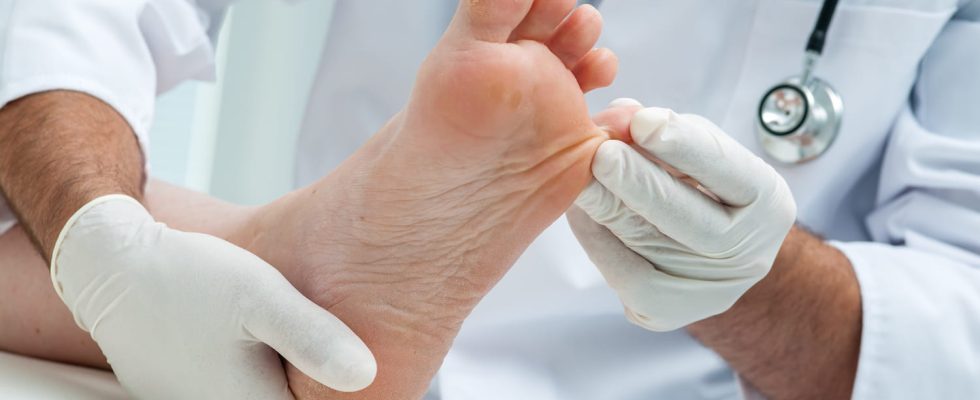On the foot, the skin, the nail, the vagina, the glans or the tongue… What are the typical symptoms of mycosis? Which fungus is responsible? How to get rid of this very unpleasant condition?
A mycosis is a infection caused by development of tiny fungi in some part of the body. “There are as many fungal infections as fungi”, explains Dr. Yves Fouré, general practitioner. Fungal infections can affect many areas of the body, in particular the digestive and genital tracts, the nails and more generally the skin. Hot and humid environments favor its multiplication, which explains their frequent location at the level of the feet or areas of folds (groin, armpits, toes, etc.). “Not all fungi are pathogenic”, says Dr. Fouré. The body is naturally colonized by these fungi, the proliferation of which can generate an infectious phenomenon.
A very common kind of causative microorganism is candida albicans. Present naturally in our mucous membranes, it is responsible, when it proliferates, for candidiasis, a form of mycosis which can affect the vulvar, oral, nail or skin region. Another type of fungus responsible for fungal infections in the skin, nails and hair: dermatophytes, which belong to the genera Trichophyton, Microsporum and Epidermophyton.
“Symptoms vary depending on the location of the mycosis and the type of fungus involved”, explains Dr. Fouré.
On the skin, a mycosis leads to the appearance of red patches, with small whitish skin or vesicular and oozing lesions, accompanied by severe itching. An infection with the Malassezia fungus can be responsible for pityriasis versicolor, a skin condition characterized by small brown spots on the skin.
At the level of the feet and between the toes, it causes itching, oozing of the skin which may crack and become mottled. On the nails, a mycosis causes a thickening, a crumbling of the nail which becomes fragile and breaks more easily.
A vaginal mycosis causes itching, thick and sometimes odorous white discharge. “Women can feel during menopause vaginal dryness responsible for itching. They can think of a mycosis, when it is not”says Dr. Fouré.
In the mouth, “thrush” is accompanied by redness in the cheeks and tongue, a drying of the mucous membranes which are covered with a white coating. In other forms of oral yeast infection, the tongue may become red and painful, or even dark turning black.
Certain factors favor cutaneous mycosis: damp heat, excessive perspiration, wearing closed shoes, poor hygiene. People who frequent municipal swimming pools can be prone to it, as can those who are undergoing therapeutic treatment (antibiotics, corticosteroids). “Stroking your pet and not washing your hands afterwards can be responsible for the proliferation of fungi”, adds Dr. Fauré. Moreover, pregnancy is a risky period. Certain pathologies, such as diabetes, are also associated with more frequent fungal infections. At the vaginal level, mycosis can be linked to prolonged wearing of unsuitable clothing (too tight), prolonged treatment with antibiotics, visiting public places such as swimming pools, saunas, etc. “The idea that she might be related to a lack of hygiene is false. On the contrary, an excess of hygiene results in stripping and unbalancing the vaginal flora, which makes the bed of mycosis.
antifungal drugs in the form of cream, ointment, spray, powder, nail polish, tablet or egg can be prescribed. Among the natural treatments, we can mention the lapacho (or pau d’arco). In herbal medicine, it is used for its inner bark, which contains the sap. This bark acts as an antiseptic and anti-inflammatory. In all its forms, lapacho is indicated to reduce infections. A decoction used twice a day in a foot bath helps to relieve mycosis.
Another natural remedy: the aloe vera, perennial plant known for the softening gel contained in its leaves. It also has antifungal and antibacterial properties, which make it an excellent ally against skin lesions. In case of mycosis, aloe gel is recommended for local application on the infected area, whatever the part of the body. Aloe vera is registered on the list of medicinal plants of the French pharmacopoeia.
On the health forum: discussions about fungal infections
To remember
► A mycosis is an infection caused by the development of tiny fungi in some part of the body.
► On the skin, a mycosis leads to the appearance of red patches, with small whitish skins.
► A vaginal mycosis causes itching, thick and sometimes odorous white losses.
► Antifungal medication in the form of cream, ointment, spray, powder, nail polish, may be prescribed.
► Taking antibiotics for a long time can be responsible for fungal infections.
Thanks to Dr Yves Fouré, general practitioner in La Rochelle.
